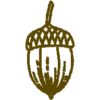Christmas Past
Last night, Colette and I made our traditional trip to the “Christmas by Candlelight” program at Old Sturbridge Village to enjoy a Christmas past.
Our first stop of the evening was in the Small House, where chestnuts were roasting over the fire. It was here that I learned the most!
When I asked the interpreter (not the one pictured, but a man who is just bursting with enthusiasm for his job!) if chestnuts were used in baking, he responded in the following manner. In the middle of summer, a farmer was too busy farming to go socializing. Even if he did have time, by the time he got to his friend’s farm, his friend was too buy farming to visit. Plus the roads were rutted and bad during the summer. But during the winter, it was another matter entirely! The roads were icy and frozen, making travel by sleigh easy. And everyone had more time, so socializing was a winter activity. Since homes did not have central heating and sleighs were unheated, once you arrived at your friend’s farm, you wanted to sit by the fire! And a fine thing to do as you sat there by the fire, was to roast and eat chestnuts! So, chestnuts were not usually used in baking, but just roasted and eaten.
He did say that chestnuts might’ve been used in stuffing. And if you roasted a turkey for your visitor, that was a rare and wonderful treat! How could that be a rare treat here in New England, where wild turkeys are everywhere? In that time, the land was nearly clear cut, which destroyed the turkeys’ habitat. Turkeys were nearly extinct in New England at the time! So, if you served your visitor turkey, you had either purchased it or raised it yourself. And raising a turkey yourself is tricky business. They are more prone to disease than chickens. If you start out with 30 turkeys, you may only have 20 full-grown ones. It takes at least 45 minutes to dress a turkey, to serve one meal to 10 people. However, a pig takes four hours to dress out, and will feed a family for a year. So, to serve your guest a roast turkey was a way to honor your guest with an expression of your time or money.
There were carolers singing!
Hot cider heating over the fire, ready for mulling. The mulling irons are on the hearth heating up too.
The small bonfire on the town green attracts groups of chilled visitors off and on throughout the evening.
Inside the parsonage, which was beautifully decorated, there was a display of Christmas cards. I was surprised to learn that Christmas cards existed in the 1830′s and even earlier. At that time they were handmade. The first printed Christmas card was made in 1840.
In the kitchen of the Parsonage, they were making fruitcake (the ingredients assembled here).
Then it was on to the tinsmith’s shop, with all its beauty of light…one of my favorite stops.
We were served “sugarplums”. The original sugarplum was nothing more than a sugar-coated fennel seed, and existed as a treat since the middle ages. Here are the candy-coated fennel seeds that we were served. Tastes just like black licorice.
And this woman was smoothing melting chocolate to a glossy texture. With this she would make hot chocolate.
This is the cocoa plant.
The melted chocolate might’ve also been poured into a puddle (or a mold) to harden and be used for baking. Here is a modern bar of baking chocolate, and next to it a cake of chocolate as you might have used in the 1800′s.
Our last stop of the evening was in a small building where one man’s nativity scene, hand-built over a period of decades, was on display. He made all those buildings…out of styrofoam! Over it all was a velvet ribbon with the words, “Glory to God in the highest and on earth peace, goodwill to men” written in Latin.
It was a lovely evening! We’ll be back next year!

















